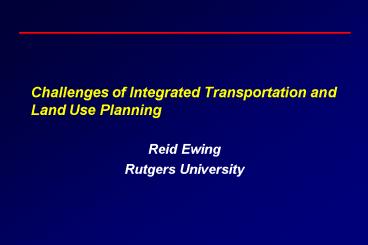Challenges of Integrated Transportation and Land Use Planning - PowerPoint PPT Presentation
1 / 59
Title:
Challenges of Integrated Transportation and Land Use Planning
Description:
Rail Lines Without Riders. Sidewalks Without Pedestrians. Limits of New Urbanism ... Westside MAX Line -- Suburban TOD. Land-Use Impacts. Implementing ... – PowerPoint PPT presentation
Number of Views:318
Avg rating:3.0/5.0
Title: Challenges of Integrated Transportation and Land Use Planning
1
Challenges of Integrated Transportation and Land
Use Planning
- Reid Ewing
- Rutgers University
2
The Challenges
- New Vision and Goals
- New Performance Measures
- Mutually Supportive Land Use Patterns-Transportati
on Facilities - Model Enhancements
- Implementing Mechanisms
3
New Vision and Goals
4
Floridas Definition of Sprawl
- (Rule 9J-5.003, Florida Administrative Code)
- Leapfrog or Scattered Development
- Ribbon or Strip Commercial Development
- Expanses of Low-Density or Single-Use Development
5
Sprawl
6
Sprawl
7
Sprawl
8
Sprawl vs. Walk Share to Work
9
Sprawl vs. VMT per Capita
10
Demand for Alternatives
- Changing American Demographics
- Desire for Community and Neighborliness
- Growing Frustration with Congestion
- Growing Interest in Health and Fitness
11
Too Much Grass to Mow
12
We Are Not European
13
Charlotte Corridors and Wedges Plan
14
It Can Happen
15
New Performance Measures
16
Commonly Used Performance Measures
17
The Bible
Are these really the best measures for quality
of transportation service?
18
Old Speed Paradigm - Roadway LOS
19
New Paradigms
20
TEA-21 Planning Factors
- Economic Vitality
- Accessibility and Mobility Options
- Safety and Security for all Users
- Environmental Protection, Energy Conservation,
and Quality of Life - Enhanced Modal Integration and Connectivity
- Efficient System Management and Operation
- System Preservation
21
Oregons Transportation Policy Rule
- Rule requires MPOs to reduce VMT per capita by
10 over 20 years in metro areas with more than 1
million population, and by 5 over 20 years in
metro areas with 1 million or less population
22
New Florida Law
- Multimodal Development District law allows local
governments to establish multimodal
level-of-service standards that rely primarily on
nonvehicular modes of transportation within a
district
23
New Maryland Law
- Transportation Funding Areas Law requires the
Department of Transportation (DOT) to establish
measurable long-term and short-term performance
goals in designated smart growth areas for
increasing the systemwide share of trips by mass
transit, walking, bicycling, and high occupancy
vehicles
24
Mutually Supportive Land-Use Patterns and
Transportation Facilities
25
Rail Lines Without Riders
26
Sidewalks Without Pedestrians
27
Limits of New Urbanism
28
Cognitive Dissonance
29
The Future Belongs to Hybrids
30
Megatrends
- In a relatively short time, the unified mass
society has fractionalized into many diverse
groups of people with a wide array of different
taste and values, what advertisers call a
market-segmented, market-decentralized society. - Naisbitt 1982
31
Urban Refill
32
Green Development
33
Transit-Oriented Development
34
Pedestrian Villages
35
Hybrid Communities
36
Hybrid Neighborhoods
37
Model Enhancements
38
Travel Demand Modeling Issue
- Conventional 4-step models are not sensitive to
effects of density, mix, and design on travel
behavior
39
Differences in Travel Patterns
- Vehicle Ownership
- Home-Based Trip Productions
- Non-Home Based Trip Attractions
- Intrazonal Trips
- Transit Trips
- Walk Trips
- Peak Hour Factors
40
TRANSIMS Framework
41
LUTRAQ Study Area
42
Different Future Land Use Patterns
43
Less VMT (and Everything Else) with LUTRAQ
44
Westside MAX Line -- Suburban TOD
45
Land-Use Impacts
46
Implementing Mechanisms
47
Examples
- Adequate Public Facilities Requirements
- Transit-Oriented Development
- Context-Sensitive Highway Design
- Traffic Calming
- Access Management
- Regional Growth Management
48
Change in VMT Per Capita (1990-99)
Baltimore 2.15
Orlando 3.95
Portland 4.64
49
Florida Growth Management General Failure
50
1985 Concurrency Requirement
51
Constant Reform Will They Ever Get It Right?
52
Transportation and Land Use Study Committee
The state land planning agency and the
Department of Transportation shall evaluate the
statutory provisions relating to land use and
transportation coordination and planningand
shall consider changes to statutes, as well as to
all pertinent rules 1998 Florida Legislative
Session
53
Oregon Growth Management Mixed Results
54
Regulatory Tools
- Urban Growth Boundaries
- Density Targets
- Transportation Policy Rule
55
Documented Accomplishments
- Stronger Downtown Employment Base
- Higher Suburban Densities
- Less Land Consumption
56
Maryland Smart Growth Promising Alternative
57
Inside and Outside Games
58
Smart Growth Results
- The Good News
- 75 of new parcels are INSIDE PFAs
- Thru Rural Legacy and related POS projects,
committed 137 million over last 4 years to
permanently protect 54,000 acres. - In last 7 years, total MD acres protected
increased 40, from 589,000 to 825,000 acres - The Bad News
- 75 of acreage developed is OUTSIDE PFAs
- The average lot size OUTSIDE PFAs is 8 times the
size of lots INSIDE PFAs - County-specific performance varies widely
59
Investments Altered by Smart Growth
5 BYPASSES
550 ACRE TRACT
2 DISTRICT COURTS
COUNTY BLDG.































